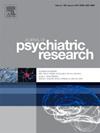Consumption of negative media content mediates the association between levels of trauma exposure and insomnia severity in Hispanic young adults
IF 3.2
2区 医学
Q1 PSYCHIATRY
引用次数: 0
Abstract
Research has shown that individuals who have experienced traumatic events are at greater risk of developing severe insomnia than those without trauma. Further, according to the stress sensitization hypothesis, victims of multiple traumas, compared to those who have experienced a single trauma, are particularly vulnerable to severe insomnia. One potential mechanism underlying the association between trauma experiences and insomnia is media exposure. Although avoidance behaviors are symptoms of posttraumatic stress, victims of traumas also demonstrate attentional bias toward threats and difficulty disengaging attention from threats. These cognitive tendencies may result in heightened vigilance to negative media content, particularly trauma-related content, leading to insomnia. The current study examined a mediation model in which trauma history (multiple traumas, single trauma, and no trauma) was the predictor, media exposure variables were the mediators, and insomnia was the outcome. Participants were predominantly Hispanic college students consisting of 116 victims of multiple traumas, 202 victims of a single trauma, and 378 individuals with no trauma. The multiple traumas group reported significantly elevated insomnia symptoms and more frequent viewing of trauma-related media content than the single trauma group and no trauma group. Trauma-related media content partially but significantly mediated the association between each group membership and insomnia. These findings highlight the need for assessment and interventions for media use when treating insomnia in trauma victims, particularly those with multiple trauma experiences.
负面媒体内容的消费介导了西班牙裔年轻人创伤暴露水平与失眠严重程度之间的关联
研究表明,经历过创伤事件的人比没有创伤的人患严重失眠的风险更大。此外,根据压力致敏假说,与那些只经历过一次创伤的人相比,多次创伤的受害者特别容易出现严重的失眠。创伤经历和失眠之间联系的一个潜在机制是媒体暴露。虽然逃避行为是创伤后应激的症状,但创伤受害者也表现出对威胁的注意偏见和难以从威胁中脱离注意力。这些认知倾向可能导致对负面媒体内容,特别是与创伤有关的内容的高度警惕,从而导致失眠。目前的研究检验了一个中介模型,其中创伤史(多重创伤、单一创伤和无创伤)是预测因子,媒体暴露变量是中介因子,失眠是结果。参与者主要是西班牙裔大学生,包括116名多重创伤受害者,202名单一创伤受害者和378名没有创伤的人。与单一创伤组和无创伤组相比,多重创伤组报告失眠症状显著升高,并且更频繁地观看与创伤相关的媒体内容。创伤相关媒体内容部分但显著地介导各组成员与失眠之间的关联。这些发现强调了在治疗创伤患者失眠时,特别是那些有多次创伤经历的患者,需要对媒体的使用进行评估和干预。
本文章由计算机程序翻译,如有差异,请以英文原文为准。
求助全文
约1分钟内获得全文
求助全文
来源期刊

Journal of psychiatric research
医学-精神病学
CiteScore
7.30
自引率
2.10%
发文量
622
审稿时长
130 days
期刊介绍:
Founded in 1961 to report on the latest work in psychiatry and cognate disciplines, the Journal of Psychiatric Research is dedicated to innovative and timely studies of four important areas of research:
(1) clinical studies of all disciplines relating to psychiatric illness, as well as normal human behaviour, including biochemical, physiological, genetic, environmental, social, psychological and epidemiological factors;
(2) basic studies pertaining to psychiatry in such fields as neuropsychopharmacology, neuroendocrinology, electrophysiology, genetics, experimental psychology and epidemiology;
(3) the growing application of clinical laboratory techniques in psychiatry, including imagery and spectroscopy of the brain, molecular biology and computer sciences;
 求助内容:
求助内容: 应助结果提醒方式:
应助结果提醒方式:


